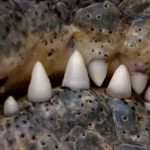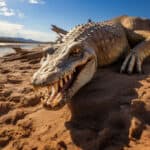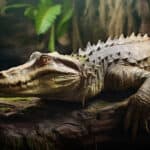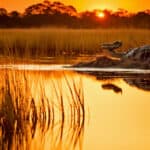Introduction
Saltwater crocodiles, also known as estuarine crocodiles or “salties,” are the largest living reptiles on Earth. These formidable creatures are found in the brackish and saltwater habitats of the Indo-Pacific region, including Southeast Asia, Northern Australia, and the eastern coast of India. With their powerful jaws, incredible strength, and adaptability to various environments, saltwater crocodiles have managed to thrive in both freshwater and marine ecosystems. Let’s explore some key facts about where these fascinating reptiles call home.
Key Takeaways
| Location | Description |
|---|---|
| Southeast Asia | Saltwater crocodiles are found in countries like Indonesia, Malaysia, and Thailand. |
| Northern Australia | These crocodiles inhabit the rivers, swamps, and coastal areas of Northern Australia. |
| Eastern coast of India | Saltwater crocodiles can be found along the eastern coast of India, particularly in the Sundarbans mangrove forests. |
Note: The table above provides a concise overview of the main regions where saltwater crocodiles live.
The Habitat of Saltwater Crocodiles
General Overview of Saltwater Crocodile Habitats
Saltwater crocodiles, also known as estuarine crocodiles, are found in various regions around the world. These impressive reptiles have a wide distribution and can be found in both saltwater and freshwater habitats. They are known to inhabit areas such as rivers, estuaries, mangrove swamps, and coastal regions.
The saltwater crocodile is the largest living reptile, with males reaching lengths of up to 6 meters or more. These crocodiles have a powerful build, with a large head, strong jaws, and sharp teeth. Their eyes and nostrils are situated on top of their head, allowing them to remain partially submerged in the water while keeping an eye out for prey.
The Climate and Environment Preferred by Saltwater Crocodiles
Saltwater crocodiles thrive in warm tropical climates, where they can regulate their body temperature by basking in the sun or cooling off in the water. They are most commonly found in regions with high temperatures and high humidity, such as Northern Australia, Southeast Asia, and parts of India.
These crocodiles are well adapted to their environment and can tolerate both saltwater and freshwater conditions. They are often found in brackish water, which is a mix of saltwater and freshwater. Mangrove swamps provide an ideal habitat for saltwater crocodiles, as they offer protection, ample food sources, and suitable nesting sites.
The Biomes and Ecosystems Where Saltwater Crocodiles Thrive
Saltwater crocodiles can be found in a variety of biomes and ecosystems, showcasing their adaptability to different environments. Here are some of the key habitats where these crocodiles thrive:
-
Rivers and Estuaries: Saltwater crocodiles are commonly found in rivers and estuaries, where they can hunt for fish, crustaceans, and other aquatic prey. These habitats provide a steady source of food and are often used as travel routes between different areas.
-
Mangrove Swamps: Mangrove swamps are dense forests of salt-tolerant trees that grow along coastlines and estuaries. These swamps provide an ideal habitat for saltwater crocodiles, offering shelter, protection, and a diverse range of prey species.
-
Coastal Regions: Saltwater crocodiles are known to venture into coastal regions, including beaches and rocky shores. They can tolerate the rough surf and are capable of swimming long distances in open water.
-
Freshwater Habitats: While saltwater crocodiles are primarily associated with saltwater environments, they can also be found in freshwater habitats such as lakes, billabongs, and freshwater rivers. These crocodiles have the ability to adapt to different salinity levels and can thrive in both saltwater and freshwater conditions.
Saltwater crocodiles have a remarkable ability to adapt to various habitats, making them one of the most successful predators in their range. Their population distribution is influenced by factors such as food availability, nesting sites, and suitable living conditions. By understanding their habitat preferences, we can better appreciate these fascinating creatures and ensure their conservation in the wild.
Geographic Distribution of Saltwater Crocodiles
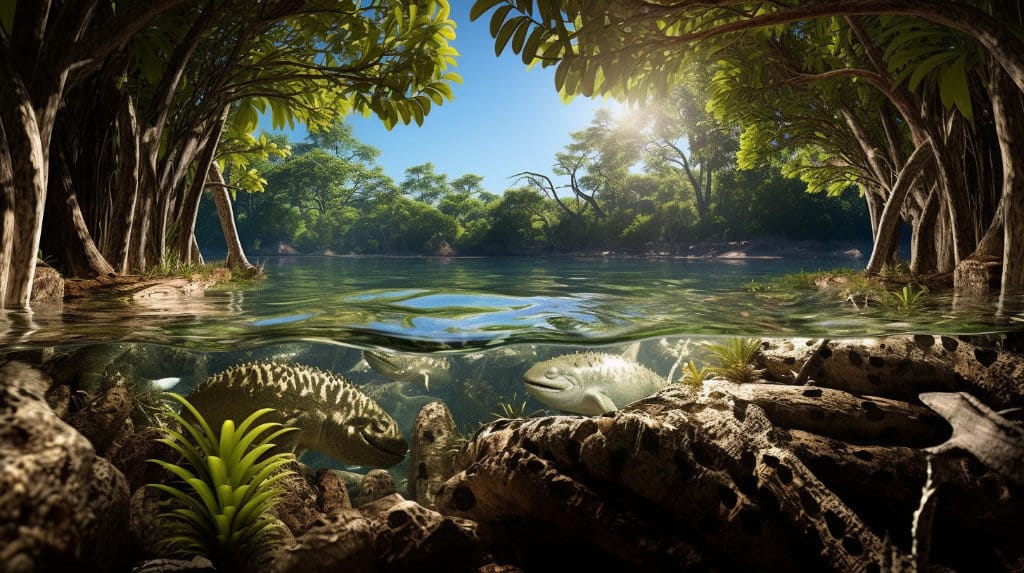
Countries Where Saltwater Crocodiles are Found
Saltwater crocodiles, also known as estuarine crocodiles, have a wide geographic distribution and can be found in several countries across the world. These countries include:
- Australia
- Papua New Guinea
- Indonesia
- Malaysia
- East Timor
- Solomon Islands
- Vanuatu
These countries provide suitable saltwater crocodile habitats, with various water bodies such as rivers, estuaries, and coastal areas that support their survival and reproduction.
Saltwater Crocodiles in Australia: How Far South Do They Live?
Australia is home to the largest population of saltwater crocodiles, and they can be found in various regions along the northern coast. However, their distribution extends further south than many people realize. Saltwater crocodiles have been known to inhabit areas as far south as the Fitzroy River in Western Australia and the Mary River in Queensland.
The ability of saltwater crocodiles to live in these southern regions is due to their ability to regulate their body temperature and adapt to different environments. While they are more commonly found in the tropical regions of Australia, their presence in the south demonstrates their adaptability and resilience.
Presence of Saltwater Crocodiles in the United States and Africa
Saltwater crocodiles are not only found in Australia and its neighboring countries but also have a presence in other parts of the world. In the United States, they can be found in the southernmost regions of Florida, particularly in the Everglades National Park. These crocodiles have established a population in the warm and subtropical climate of Florida.
In Africa, saltwater crocodiles can be found in countries such as Madagascar, Mozambique, and South Africa. They inhabit various water bodies, including rivers, lakes, and coastal areas. The crocodile populations in Africa are smaller compared to those in Australia, but they still play an important role in the local ecosystems.
Overall, the geographic distribution of saltwater crocodiles spans across different continents and countries, showcasing their ability to adapt to various environments. These apex predators have managed to thrive in diverse habitats, making them a fascinating species to study and observe.
| Country | Saltwater Crocodile Population |
|---|---|
| Australia | Large |
| Papua New Guinea | Moderate |
| Indonesia | Moderate |
| Malaysia | Moderate |
| East Timor | Small |
| Solomon Islands | Small |
| Vanuatu | Small |
Note: The population sizes mentioned are relative and may vary over time due to various factors such as conservation efforts and habitat changes.
Saltwater Crocodiles and Water Bodies
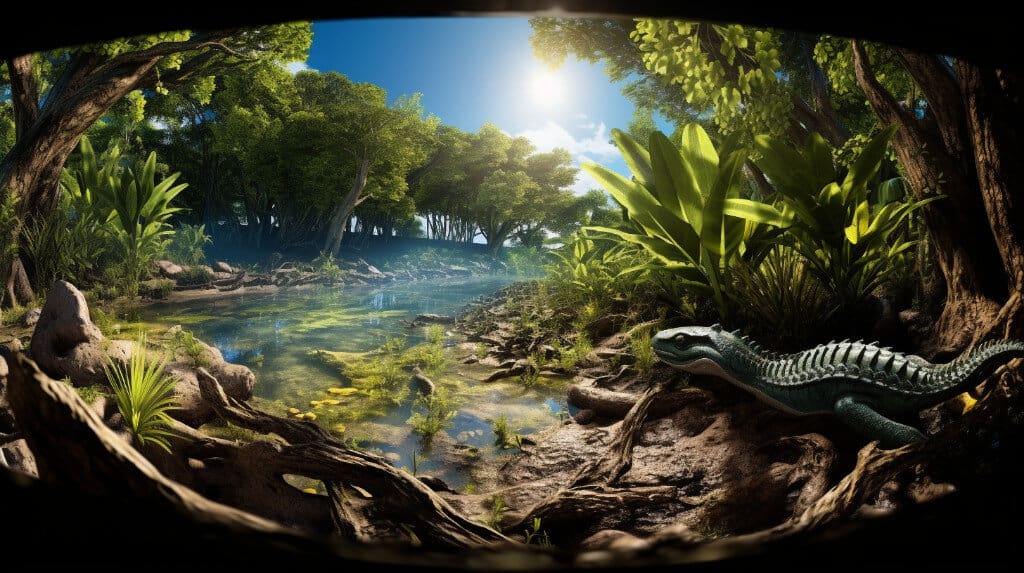
Saltwater crocodiles, also known as salties, are the largest living reptiles on Earth. They are fascinating creatures that have adapted to thrive in various water bodies, including both freshwater and saltwater environments. Let’s explore how and why saltwater crocodiles can live in these different habitats.
Saltwater Crocodiles in Freshwater: How and Why They Can Live There
Saltwater crocodiles are known to inhabit freshwater areas, such as rivers, lakes, and swamps, despite their name suggesting otherwise. This ability to live in both saltwater and freshwater environments is due to their remarkable adaptability.
One of the reasons saltwater crocodiles can survive in freshwater is their unique physiology. These reptiles have specialized glands in their bodies that allow them to excrete excess salt, enabling them to maintain the right balance of salt and water in their systems. This adaptation helps them cope with the lower salinity levels found in freshwater habitats.
In addition to their physiological adaptations, saltwater crocodiles also exhibit behavioral flexibility. They are known to travel long distances in search of suitable habitats, including freshwater areas. This ability to move between different water bodies allows them to find optimal conditions for feeding, breeding, and nesting.
When it comes to reproduction, saltwater crocodiles display interesting behaviors in freshwater environments. Female crocodiles build nests on the banks of freshwater bodies, where they lay their eggs. The nests are carefully constructed to provide a safe and warm environment for the eggs to develop. Once the eggs hatch, the young crocodiles make their way back to the water, where they begin their journey to adulthood.
Saltwater Crocodiles in the Ocean: Where They Live and How They Survive
While saltwater crocodiles are capable of living in freshwater, they are primarily associated with saltwater environments, such as estuaries, mangrove swamps, and coastal areas. These habitats provide them with abundant food sources and suitable conditions for their survival.
In the ocean, saltwater crocodiles are known to occupy specific regions with favorable conditions. They can be found in the coastal waters of Southeast Asia, Northern Australia, and the Pacific Islands. These areas offer a combination of warm temperatures, ample prey, and suitable nesting sites.
Surviving in the ocean requires saltwater crocodiles to possess a set of adaptations that enable them to navigate and thrive in this challenging environment. Their powerful jaws and sharp teeth allow them to catch and consume a variety of marine creatures, including fish, turtles, and even sharks. Their ability to close their nostrils and a special transparent eyelid that protects their eyes underwater further enhances their hunting capabilities.
Saltwater crocodiles are also excellent swimmers, capable of propelling themselves through the water with their strong tails. They can stay submerged for extended periods, using their well-developed muscles to control their movements and navigate their surroundings.
In conclusion, saltwater crocodiles are remarkable creatures that have successfully adapted to live in both freshwater and saltwater environments. Their ability to thrive in different habitats is a testament to their evolutionary resilience and their unique physiological and behavioral adaptations. Whether in freshwater or the ocean, saltwater crocodiles continue to fascinate and awe us with their presence in various water bodies worldwide.
Saltwater Crocodiles in Rainforests

Saltwater crocodiles, also known as estuarine crocodiles, are fascinating creatures that inhabit various habitats worldwide. One of the environments where these magnificent reptiles can be found is in rainforests. Let’s explore the saltwater crocodile habitat and their distribution within these lush ecosystems.
Rainforests provide an ideal setting for saltwater crocodiles due to their abundant water sources and dense vegetation. These crocodiles are known for their adaptability and can thrive in both saltwater and freshwater environments. However, they are commonly found in estuaries, mangrove swamps, and river systems that are prevalent in rainforests.
Saltwater Crocodile Range and Geography
Saltwater crocodiles have a wide range that spans across different regions. They are native to the Indo-Pacific region, including countries like Australia, India, Malaysia, and Indonesia. Within these areas, they can be found in various territories, making rainforests one of their preferred dwelling regions.
In Australia alone, saltwater crocodiles are found in the northern regions, particularly in the Northern Territory and Queensland. These areas offer the crocodiles ample space to roam and establish their territories. The abundance of waterways and suitable nesting sites in rainforests make them attractive habitats for these reptiles.
Crocodile Living Conditions and Adaptations
Saltwater crocodiles are the largest living reptiles, with males reaching lengths of up to 6 meters or more. Their size, coupled with their powerful jaws and sharp teeth, makes them formidable predators. These crocodiles are well-adapted to their environment, with features that enable them to thrive in rainforests.
One remarkable adaptation of saltwater crocodiles is their ability to close their pair of eyelids and a transparent third eyelid, called a nictitating membrane, while underwater. This protective mechanism allows them to see clearly and hunt effectively without compromising their vision.
Another interesting adaptation is their ability to hold their breath for extended periods. Saltwater crocodiles have a special valve in their throat that closes off their windpipe, preventing water from entering their lungs. This adaptation enables them to stay submerged for long periods while waiting for prey to approach.
Reproduction and Nesting
Saltwater crocodiles have a unique reproductive process. Females lay their eggs in nests made of vegetation, which are constructed near the water’s edge. The nests provide a safe and warm environment for the eggs to develop. After an incubation period of about three months, the eggs hatch, and the baby crocodiles emerge.
Interestingly, the sex of the hatchlings is determined by the temperature during incubation. Higher temperatures result in more females, while lower temperatures produce more males. This natural phenomenon helps maintain a balanced population of saltwater crocodiles in rainforest habitats.
Conservation and Protection
Due to their large size and powerful bite, saltwater crocodiles are apex predators in their ecosystems. However, they have faced significant threats from habitat loss, hunting, and illegal poaching. Efforts have been made to protect these magnificent creatures and their habitats.
In many countries, including Australia, saltwater crocodiles are protected by law, and their populations are carefully monitored. Conservation programs aim to educate the public about the importance of these reptiles in maintaining the ecological balance of rainforest ecosystems.
In conclusion, saltwater crocodiles have found a home in rainforests, where they thrive in the diverse and abundant habitats. Their adaptability, impressive size, and unique adaptations make them a remarkable species to observe and study. By understanding their habitat and distribution, we can appreciate the vital role they play in maintaining the delicate balance of rainforest ecosystems.
Lifespan of Saltwater Crocodiles
General Lifespan of Saltwater Crocodiles
Saltwater crocodiles, also known as estuarine crocodiles, are known for their impressive lifespan. These magnificent creatures have the potential to live for several decades, making them one of the longest-living reptiles on the planet.
In their natural habitat, saltwater crocodiles can live up to 70 years or more. However, various factors can influence their lifespan, including environmental conditions, availability of food, and competition for resources. Let’s explore some key aspects of their lifespan.
Crocodile Growth and Development
Saltwater crocodiles start their lives as tiny hatchlings, measuring around 25 to 30 centimeters in length. As they grow, they undergo significant changes in size, behavior, and physiology. The growth rate of crocodiles varies depending on factors such as food availability and environmental conditions.
Maturity and Reproduction
Saltwater crocodiles reach sexual maturity at around 10 to 12 years of age. Males typically grow larger than females, with an average length of 4 to 5 meters. Females, on the other hand, tend to be smaller, measuring around 3 to 4 meters in length.
During the breeding season, male crocodiles establish territories and engage in fierce battles to win the right to mate with females. Once a female is ready to lay her eggs, she constructs a nest and carefully guards it until the eggs hatch.
Lifespan in Captivity
In captivity, saltwater crocodiles can live for over 80 years, surpassing their lifespan in the wild. The controlled environment ensures that they receive proper nutrition, medical care, and protection from predators.
How Long Do Saltwater Crocodiles Live in Captivity?
Saltwater crocodiles have been known to thrive in captivity, with some individuals reaching astonishing ages. The oldest recorded saltwater crocodile in captivity lived for over 100 years, showcasing the potential for these reptiles to live long and healthy lives under human care.
The longevity of saltwater crocodiles in captivity can be attributed to the optimal living conditions provided by zoos, wildlife sanctuaries, and conservation centers. These facilities ensure that the crocodiles receive a balanced diet, suitable habitat, and regular veterinary care.
It is important to note that the lifespan of saltwater crocodiles in captivity can vary depending on individual care, genetics, and overall well-being. By providing a safe and enriching environment, experts can contribute to the longevity and well-being of these incredible creatures.
In conclusion, saltwater crocodiles have an impressive lifespan, with the potential to live for several decades in their natural habitat. Under human care, they can thrive and exceed their lifespan in the wild. By understanding and respecting their needs, we can continue to appreciate and protect these ancient reptiles for generations to come.
Conclusion
In conclusion, saltwater crocodiles are fascinating creatures that have adapted to live in a variety of habitats. They are primarily found in the coastal regions of Southeast Asia, Australia, and the Pacific Islands. These crocodiles are well-suited to both saltwater and freshwater environments, allowing them to thrive in mangrove swamps, estuaries, rivers, and even open ocean waters. With their impressive size, powerful jaws, and ability to regulate their body temperature, saltwater crocodiles are apex predators in their ecosystems. Their ability to survive in diverse environments is a testament to their resilience and adaptability as a species.
Frequently Asked Questions
Q1: Where do saltwater crocodiles live?
Saltwater crocodiles are distributed across various tropical regions. They inhabit areas from India’s east coast across Southeast Asia to northern Australia.
Q2: What countries do saltwater crocodiles live in?
Saltwater crocodiles live in multiple countries including Australia, India, and several Southeast Asian countries such as Indonesia, Vietnam, and the Philippines.
Q3: How can saltwater crocodiles live in freshwater?
Saltwater crocodiles are a versatile species that can survive in both saltwater and freshwater environments. Their body has special adaptations like excreting excess salt through their tongue, which allows them to live in different water types.
Q4: Do saltwater crocodiles live in the rainforest?
Yes, saltwater crocodiles can live in rainforests, particularly in coastal regions and around swamps and rivers where they find ample food sources.
Q5: How far south do saltwater crocodiles live in Australia?
Saltwater crocodiles can be found as far south as the northern part of Western Australia, the Northern Territory, and Queensland. They generally don’t go further south due to the cooler temperatures.
Q6: What climate do saltwater crocodiles live in?
Saltwater crocodiles live in tropical climates where it is warm and humid. This includes regions like Northern Australia, Southeast Asia, and the eastern coast of India.
Q7: How long do saltwater crocodiles live?
Saltwater crocodiles have a long lifespan and can live up to 70 years, although some have been known to live for over 100 years.
Q8: How do saltwater crocodiles survive?
Saltwater crocodiles are apex predators and survive by hunting a variety of prey including fish, birds, and mammals. They are also highly adaptable and can live in both saltwater and freshwater environments.
Q9: What environment do saltwater crocodiles live in?
Saltwater crocodiles inhabit a variety of environments including rivers, estuaries, and coastal regions. They can also be found in swamps and rainforests near the coast.
Q10: Where do most saltwater crocodiles live?
The majority of the world’s saltwater crocodile population is found in Australia, specifically in the northern regions. However, they are also found in several other countries across Southeast Asia and the eastern coast of India.

